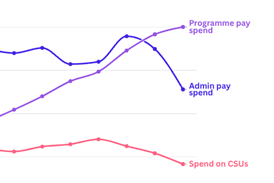An HSJ webinar brought together a panel of experts to consider how tackling the backlog might perhaps become synonymous with tackling inequality. Claire Read reports

“For decades, if not centuries, we’ve really got it right on the analysis of inequality,” says Kiran Patel, consultant cardiologist and chief medical officer at University Hospitals Coventry and Warwickshire Trust. What those in healthcare are less good at, he argued, is “doing something about it”.
In association with
That’s a situation Professor Patel and his colleagues are working hard to redress. At the height of the first wave of covid, with elective care activity paused, they were already thinking about the restoration of services and, more specifically, how to avoid exacerbating the inequalities the pandemic was starkly illustrating.
“We’ve spent 18 months designing what our services would look like, because we know that if we only restore with respect to waiting lists that drives inequality. If we only focus on 104 week waits, or 78 week waits, or 52 week waits, our inequalities are going to widen.”
The question of whether addressing the backlog can be used as a means of addressing inequalities is very much a live one. It is notable that NHS England’s national healthcare inequalities improvement programme – which emerged during the pandemic – has restoring services inclusively as one of its five key priorities. And this year’s operational planning guidance emphasises that waiting lists should be segregated by ethnicity and deprivation.
The webinar held in mid-May as part of HSJ’s Elective Care Recovery Virtual Series was therefore a timely one. The event, held in association with Optum, brought together a small panel of experts to consider how tackling the backlog might perhaps become synonymous with tackling inequality.
Jonathan Pearson-Studdard is chair of the health inequalities programme board at Northumbria Healthcare Foundation Trust, head of health analytics at Lane Clark & Peacock, and chair elect of the Royal Society of Public Health. He argued the first step the system must take is to make “a real commitment” that in managing the huge numbers of patients waiting for care “we won’t make inequality worse”.
“Part of that is actually being transparent about the scale of the inequalities in our current waiting lists,” he argued. “If we can say: ‘This is the current state of it, this is what we’re doing,’ then we can actively monitor [whether that action is making a difference].”
It is likely that the ability to accurately assess the current state will vary, however. Said Sarah Scobie, deputy director of research at Nuffield Trust: “There are huge differences in healthy life expectancy between the most and least deprived, and we know inequalities also exist in the delivery of care, but I think it’s fair to say that some of these inequalities are more visible than others.
“We have better data on some areas than others – for example on ethnicity, there are lots of issues with data quality.”
That challenge is one which NHS England’s national healthcare inequalities improvement programme is seeking to help tackle. Mary Hill, the programme’s head of policy, characterised “the data question” as “huge and important”.
“And so one of the things we’re doing nationally,” she said, “is creating a health inequalities improvement dashboard. It aims to bring together in one place all of the health inequalities indicators, so that it provides a practical tool for people working at the local level around those indicators.”
She emphasised, though, that this will need to be “triangulated with local data” if it is to have the maximum impact.
In Coventry and Warwickshire, that local understanding has helped inform an approach to elective care scheduling which deliberately seeks to address inequality. “We asked all of our clinicians to say what drives clinical outcomes in their pathway,” explained Professor Patel. “And then we designed an elective care scheduling tool which takes all of those determinants of health outcomes [into account] and reorders the waiting lists.”
The determinants include clinical data: whether a patient has diabetes, high blood pressure or high cholesterol, for instance, will influence their place on the waiting list for coronary bypass surgery. But added to that is existing healthcare utilisation – “if we had two patients, one of whom has been into ED four times with chest pain in the last month, we’re probably going to expedite their surgery [over] somebody who hasn’t” – and, crucially, what Professor Patel terms a social value judgement: the scale of the difference to someone’s life that treatment will make.
“Clinical interventions aren’t undertaken just because they make people free of chest pain – they make them free of chest pain in order to achieve something else, and [what] that [is] varies. So we’ve actually undertaken what I call personalisation of population health. When we talk about personalised healthcare, it’s not just about genomics and genetics. It’s about this realm of clinical and non-clinical social determinants that is important.”
These are provocative areas, leading to questions such as whether a parent unable to work due to their condition should be prioritised over someone who is retired and living on a comfortable pension. But considering them could lead to more equal and holistic care. It was a point summed up by Jim Forrer, who is a clinical lead at Optum but also a practising GP.
“The NHS, as brilliant as it is, provides quite a flat offer to the society we have in front of us and the needs they have,” he suggested. “The ways in are static; we don’t reach out as much as we perhaps could to communities with different identities, different needs, different features, different access to transport, different language needs, different levels of advocacy.
“Our view [in determining clinical need and priority] is generally quite simple: the percentage blockage of a particular artery; how bad the knee is, what’s the severity of the pain?
“But those mechanical and biological features are filtered through a psychological experience of how anxious a patient is, what pressures they have upon themselves, whether their condition stops them going up the ladder to do their scaffolding job, or whether it doesn’t really impact their work because they’re mostly seated at home in front of the computer.”
And so the backlog, as challenging as it is, could be a chance to start considering those factors – and addressing longstanding and deep inequality.
An on demand version of this webinar is available.
If you had previously registered as a viewer for the event, click here or check your email for the link to the recording.
If you hadn’t previously registered, complete the form here. You will then be sent details on how to access the recording.


























